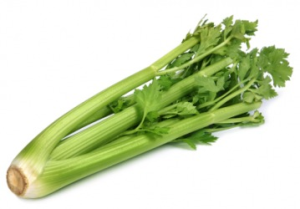Celery
 Overview
Overview
Celery, Apium Graveolens, belongs to the same botanical family as carrots, parsley, and fennel. The plant consists of individual stalks, which are tightly bound together by a singular base, with leaves on top; it grows to between 12 and 16 inches tall and is harvested only once every two years. While the stalks are the most common food source, celery leaves, roots, and seeds are also edible and often used in cooking. Celery is most commonly light green in color; however, when grown in the absence of direct sunlight, celery may be white. Celery stalks should be firm and crisp. Celery root is typically a light brown color and should also be firm.
History
Celery has been used by humans for a very long time; it was first referenced in Homer’s The Odyssey in the ninth century B.C. Originally, celery’s primary use was not as a food source; rather, it was used to make athletic crowns by Greeks, while Romans used it as seasoning. It was also often used for its medicinal properties. It was not until the eighteenth century in Europe that celery became a more traditional food source. Celery was introduced in the United States in the early 1800s.
Nutritional Information
Celery is a very low calorie food, but it also contains many nutrients. One stalk of celery typically has fewer than 10 calories, and it is high in Vitamins B and C; the leaves are especially high in Vitamin A. Celery is also a great source of fiber, potassium, folic acid, and calcium. Celery is higher in sodium than other vegetables; however, there is only about 32 milligrams of sodium per celery stalk, which is a rather insignificant amount, even for those with sodium sensitivities. Also unlike other vegetables, celery retains many of its nutrients and health benefits even after being cooked.
Health Benefits of Celery
Celery has a wealth of health benefits to offer. Among its most prominent benefits are its apparent cancer-fighting properties. There are several different kinds of cancer-fighting compounds within celery that combat the disease in different ways. For example, acetylenics and phenolic acid both inhibit the growth of tumor cells while coumarins prevent the body from sustaining damage by free radicals. Coumarins have also been shown to help fight cancer by boosting the activity of some types of white blood cells. The compounds may also be helpful in treating migraines and lowering blood pressure.
Celery has also been shown to act as an anti-inflammatory and used in the treatment of conditions such as arthritis, gout, and asthma. One study showed that celery can significantly reduce joint pain that had previously been persistent and somewhat debilitating. Participants in the study had experienced joint pain persistently, whether continually or intermittently, for at least ten years. After taking about 70 milligrams of celery extract daily, the average pain rating of participants was decreased significantly in just three weeks. A compound in celery that seems to lower the production of uric acid in the body may contribute to such results.
Celery also helps to flush toxins from the body, which can lead to further health benefits. The potassium and sodium in celery help promote urine production, which allows the body to more effectively flush toxins and unnecessary fluid from the body. This process also helps promote kidney functioning and in turn may help prevent the development of kidney stones. Furthermore, the effective elimination of harmful toxins from the body may also help lower cholesterol and prevent cancer.
Finally, celery offers a good way to replace electrolytes and water that is lost during exercise. It has also been show to calm nerves and relax muscles.
References
- Holford, P. The optimum nutrition bible, Little Brown Group (2004)
- Holford, P & Lawson, S. Optimum Nutrition Made Easy How to achieve optimum health, Piatkus Books (2008)
- Murray, M.T. et al., Encyclopedia of healing foods, London : Piatkus (2005)
- The National Research Council. Recommended Dietary Allowances, 10th ed, National Academy of Sciences (1989)
- Werbach, M. Nutritional Influences on Illness, 2nd ed, Third Line Press (1993)
Posted in Celery
Ask a Question Or Join a Discussion


